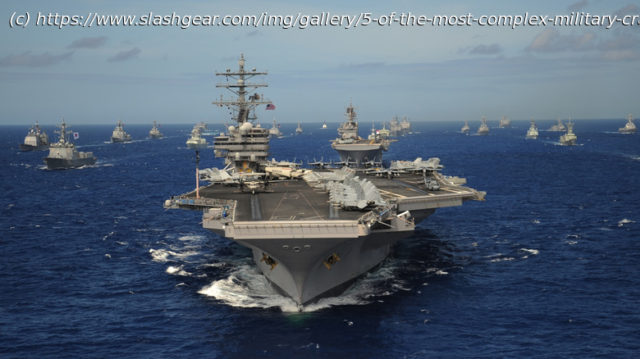From aircraft carriers to nuclear submarines, these five vessels represent the peak of complexity, capability — and over engineering — in the U.S. Navy.
the U.S. Navy operates at a scale of technical sophistication that would have seemed like sci-fi just a generation ago. And this isn’t pursued solely as our «carry a big stick» doctrine either, though that definitely plays a part. To maintain our military dominance, we demand capabilities from our naval hardware that only cutting edge technology can achieve. Our U.S. Navy destroyers need to hit targets hundreds of miles away, detect threats a thousand miles out, talk to aircraft and satellites, and defend themselves against attack.
And these destroyers, designated with the letters DD, have to do all that simultaneously, more often than not. Nuclear aircraft carriers (which carry the CVN designation) need to launch, recover, and maintain a whole aircraft squadron while serving as a mobile command and control center. A nuclear submarine needs to stay undetected for weeks, or even months, while serving its deterrent roles. So, these aren’t necessarily the fastest Navy ships, the most produced, or the best-armed. But they push the boundaries of what naval engineering can achieve.
Some combine multiple mission profiles into a single platform. Others pioneer entirely new operational concepts. However, every single one is extraordinarily expensive, complex, and specialized — though that’s not to say that every project on this list has been a success. Some did fall victim to their own complexity. So, here are the five most complex vessels in the U.S. Navy, as of 2025.Aircraft Carriers (Ford Class)
Though carriers have always been complex vessels, the new Ford-class ships take that concept to another level entirely. What should have been an upgraded Nimitz-class fleet turned into an experimental platform, with virtually every major system upgraded or modified. Amongst other things, this class of carrier was the first to receive an EMALS – short for Electromagnetic Aircraft Launch System, which can launch an aircraft every 45 seconds. This system replaced older-generation steam catapults that had been in service on carriers for decades.
However, not everything went to plan: the first Ford carrier was delivered without its Advanced Weapons Elevators (AWEs), as the new electromagnetic system was plagued by failures. Also, the lavatories could not flush because the sewage system was initially quite unreliable. Then there’s the AAG, or advanced arresting gear system, meant to catch landing planes that ditched the old hydraulic system for water turbines. Both of these systems had not been used before they debuted on the USS Gerald R. Ford in 2017.
The power systems are also mind-bogglingly complex, generating three times more power than the Nimitz-class ships they replaced. This happens through twin A1B reactors that make a combined total of 600 MW of power. What’s even more impressive is that the Ford carriers stretch 1,092 feet — only slightly longer than its 1,040 ft Nimitz-class predecessors. Overall, it’s a fantastic, over-engineered platform that had a few teething problems.






